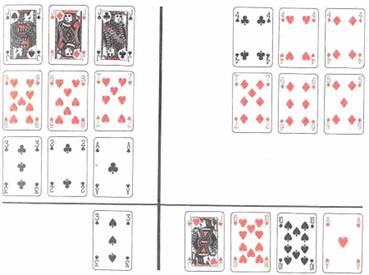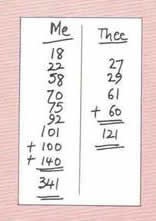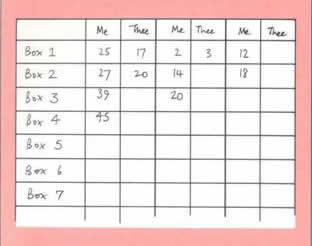It must be remembered that poker cards cannot be laid off on a knocker who goes gin. Going gin therefore guards against being undercut. A player who goes gin scores a bonus of 25 on top of the point count.
The first player to score 100 points wins the game, but scoring does not end there. The winner of the game adds 100 points bonus to his score. Each player then adds 20 points to his score for each of his ‘boxes’ each deal he won.
The winner wins by the difference in the two scores. This difference is doubled if the lower did not score a point. This is called a ‘shutout’ or ‘Schneider’. The score of a completed game is illustrated overleaf.

There is a more complex scoring system, which was used in the days of popularity in Hollywood and which is known as Hollywood rummy scoring.
The scores are recorded on a sheet of ruled paper. The first time a player wins a deal he enters the points in the first column only. The second time he enters the points in the second column and also adds them to the score in the first column.
The third column and adds them to the score in the first two columns. Thereafter points won are added to the scores in all three columns. The illustration below represents a game in progress, showing some scores entered.

When the score of a player in a column reaches 100 or more, the column is closed. The player winning it scores a bonus of 100 points, and each player scores 20 points for each box won, as in the orthodox scoring.
The winner wins by the difference in the scores, and if the loser fails to score in a column the difference is doubled. A player who is shut out in the first column must clearly make his first entry in the second column. A poker game ends when all three columns are won.
STRATEGY
Players must use judgment in deciding how long to hold high cards presenting a good chance of a set. For three or four draws it might pay to hold them, as high cards are likely to be discarded by the opponent.
Many gin hands are won after only five or six draws, however, with six or seven cards in sets, and three or four unmatched. At this stage, therefore, a player should consider discarding these high cards in favour of lower ones.
Low cards, if drawn ought to be retained, as clearly they reduce the loss if your opponent wins, and they enable a player to knock as soon as he holds two or three sets.
A player in a position to knock will have to weigh the chances of being undercut. In the first four turns, a player might feel safe in knocking as soon as he can. From about the eighth turn, however, he might decide to knock only with a count of, say, five or lower.
In deciding whether to knock he will consider the upcards which both poker players have taken and try to calculate how many sets his opponent has and what he might be able to lay off.
With an opportunity to knock with a low count it is usually a mistake to wait for gin. If your opponent goes gin first it is a costly error.

